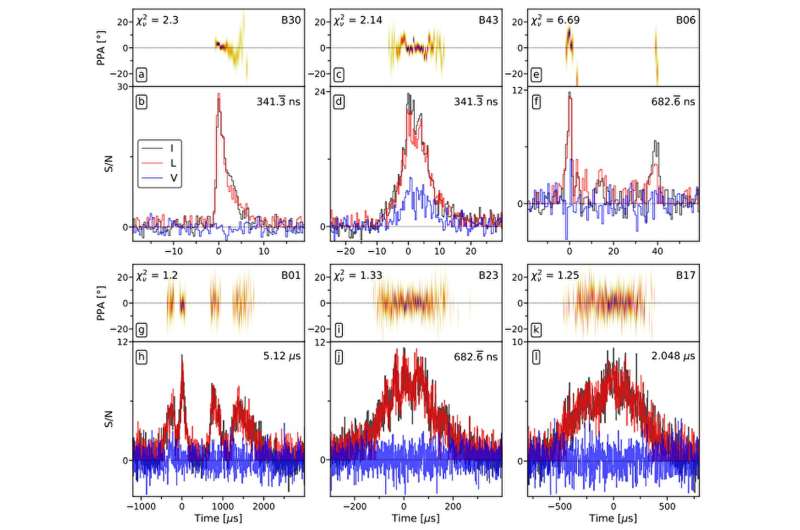July 26, 2023 report
This article has been reviewed according to Science X's editorial process and policies. Editors have highlighted the following attributes while ensuring the content's credibility:
fact-checked
preprint
trusted source
proofread
Astronomers find multiple microsecond-length fast radio bursts in data from the Green Bank Telescope

A team of space scientists from several institutions in The Netherlands, two in the U.S. and one in Sweden, has found evidence of multiple microsecond-length fast radio bursts (FRBs) by analyzing data from the Green Bank Telescope, in West Virginia. The group has posted their study on the arXiv preprint server.
Prior research has led to the discovery of FRBs, which are bursts of radio waves coming from outside the Milky Way galaxy. Though their origin is still not known, several theories have been proposed—the two leading candidates are emissions from a flaring magnetar or from the jet of an accreting black hole. Most FRBs have been found to last on the order of a few milliseconds.
But last year, astronomer Kenzie Nimmo, found evidence of much shorter bursts—a discovery that led many in the community to wonder if there might be even shorter bursts. To find out, the team turned to data from the Green Bank Telescope—a facility with the largest steerable disk in the world.
Data from the telescope has been studied before, but this time, the researchers looked for evidence of much shorter FRBs. To that end, they focused on observations of the repeating FRB 20121102A. They believed it might be possible that at least some FRBs come to us as very short bursts of radio waves because they have experienced interference in their trip across space. Such interference could conceivably cut a single long burst into a series of short bursts. Within these parameters, the team found 19 extremely short FRBs, all between 5 and 15 microseconds.
In studying the bursts, the team found that other than duration, the FRBs were nearly identical in nature to longer FRBs. This finding, they suggest, adds more credence to the leading theories, rather than those that propose the microsecond bursts come about due to a shock of some sort. They also suggest that their findings likely offer more new information regarding the environment from which FRBs arise, rather than their source. The team also suggests that there are likely a lot more FRBs making their way to planet Earth than has been suspected.
More information: M. P. Snelders et al, Microsecond-duration bursts from FRB 20121102A, arXiv (2023). DOI: 10.48550/arxiv.2307.02303
Journal information: arXiv
© 2023 Science X Network
This blog article is based on "Astronomers announce haul of the shortest fast radio bursts ever discovered" by Ethan van Woerkom, published in Physics World on July 24, 2023.



















